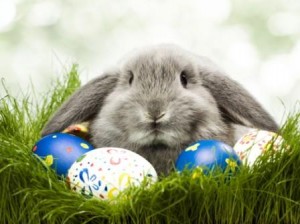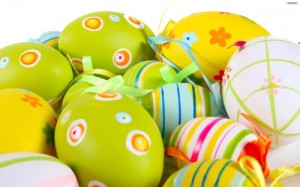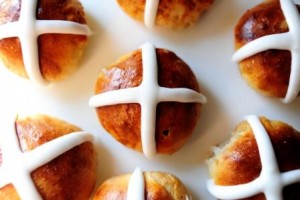Here is some interesting trivia about Easter symbology that you may not have known! (from www.wilstar.com & www.starcraftsob.com)
Traditions of Easter
Since its conception as a holy celebration in the second century, Easter has had its non-religious side. In fact, like it or not, Easter was originally a pagan festival.
 The ancient Saxons celebrated the return of spring with an uproarious festival commemorating their goddess of offspring and of springtime, Eostre. (You’ll also see this spelled Oestara and Eostara.) When the second-century Christian missionaries encountered the tribes of the north with their pagan celebrations, they attempted to convert them to Christianity. They did so, however, in a clandestine manner.
The ancient Saxons celebrated the return of spring with an uproarious festival commemorating their goddess of offspring and of springtime, Eostre. (You’ll also see this spelled Oestara and Eostara.) When the second-century Christian missionaries encountered the tribes of the north with their pagan celebrations, they attempted to convert them to Christianity. They did so, however, in a clandestine manner.
It would have been suicide for the very early Christian converts to celebrate their holy days with observances that did not coincide with celebrations that already existed. To save lives, the missionaries cleverly decided to spread their religious message slowly throughout the populations by allowing them to continue to celebrate pagan feasts, but to do so in a Christian manner.
As the Christian observance of the resurrection of Christ symbolised rebirth and renewal it made sense to celebrate it at the same time as the existing pagan celebration of rebirth and renewal, and to later alter the festival itself, to make it a Christian celebration as converts were slowly won over. The early name, Eostre, was eventually changed to its modern spelling, Easter.
Easter Bunny
The Easter Bunny is not a modern invention. The symbol originated with  the pagan festival of Eostre or Ostara. The Anglo-Saxon goddess of spring, rebirth, the east and dawn, Eostre, was worshipped by the Anglo-Saxons through her earthly symbol, the rabbit, with coloured eggs presented to her as offerings. A lunar goddess and goddess of fertility, the pagan people connected her to the full moon (ever seen the ‘rabbit’ in the full moon?) – which is itself a symbol of fertility and promise of renewal (symbolising a full, pregnant belly).
the pagan festival of Eostre or Ostara. The Anglo-Saxon goddess of spring, rebirth, the east and dawn, Eostre, was worshipped by the Anglo-Saxons through her earthly symbol, the rabbit, with coloured eggs presented to her as offerings. A lunar goddess and goddess of fertility, the pagan people connected her to the full moon (ever seen the ‘rabbit’ in the full moon?) – which is itself a symbol of fertility and promise of renewal (symbolising a full, pregnant belly).
The Germans brought the symbol of the Easter rabbit to America. It was widely ignored by other Christians until shortly after the Civil War. In fact, Easter itself was not widely celebrated in America until after that time.
The Easter Egg
 As with the Easter Bunny and the holiday itself, the Easter Egg pre-dates the Christian holiday of Easter. The exchange of eggs in the springtime is a custom that was centuries old when Easter was first celebrated by Christians.
As with the Easter Bunny and the holiday itself, the Easter Egg pre-dates the Christian holiday of Easter. The exchange of eggs in the springtime is a custom that was centuries old when Easter was first celebrated by Christians.
From the earliest times, the egg was a symbol of rebirth in most cultures.
Eggs were often wrapped in gold leaf or, if you were a peasant, colored brightly by boiling them with the leaves or petals of certain flowers. These were then given as gifts of renewal and to bring good fortune.
Somewhere along the way, the offering of eggs became a custom for children, and today children hunt coloured eggs and place them in Easter baskets along with the modern version of Easter eggs – those made of candy or chocolate.
Hunting for and giving coloured (hard boiled) eggs is an Easter tradition practiced around the globe, including Greece, Poland, Finland, Scotland, Hungary and the Ukraine.
The Cross and Hot Cross Buns
The Cross is the symbol of the Crucifixion, as opposed to the Resurrection. However, at the Council of Nicaea, in A.D. 325, Constantine decreed that the Cross was the official symbol of Christianity. The Cross is not only a symbol of Easter, but it is more widely used, especially by the Catholic Church, as a year-round symbol of their faith.
However, the cross used on Hot Cross Buns is in fact the equal-armed  cross – a pagan symbol signifying the equilibrium of the natural order. Easter falls at Spring Equinox in the northern hemisphere – Autumn Equinox in the south – a time when the earth and sun reach a point of balance: equal day and equal night.
cross – a pagan symbol signifying the equilibrium of the natural order. Easter falls at Spring Equinox in the northern hemisphere – Autumn Equinox in the south – a time when the earth and sun reach a point of balance: equal day and equal night.
Hot cross buns are an ancient custom – probably an outgrowth of the ancient pagan sacramental cakes eaten by Anglo-Saxons in honour of the Goddess Eostre. It has been suggested that early clergy could not stop the use of the sacramental cakes, so they blessed them and decorated them with the cross.
Still another suggestion is that they represent the round, sun-like rolls of northern Europe, decorated with the equal-armed cross associated with Woden.
Anyone still doubting the pagan origins of Easter only need look at the way it is calculated. Although Christianised it still falls on the first Sunday following the first full moon after the equinox!
© Earth Goddess Wisdom – www.earthgoddesswisdom.com
